African dwarf frogs are much different from the fish you see in an aquarium.
These tiny amphibians are playful, and watching their antics in your fish tank is fun.
If you want a companion for your betta fish, you may wonder if African dwarf frogs are a good option.
So, do African dwarf frogs and betta fish make good tank mates?
With the right tank setup, African dwarf frogs and betta fish make excellent tank mates. African dwarf frogs and betta fish prefer the same water parameters. But, as with any tank mates for betta fish, you must take certain precautions for a successful pairing.

Table of Contents
Choosing the Best Tank Size: What You Need To Know

Before choosing a tank size, consider how many African dwarf frogs you want in your betta tank.
Unlike betta fish, African dwarf frogs are social creatures. Never keep less than two African dwarf frogs together.
The general rule of thumb is 2 gallons of water per frog.
A 10-gallon tank works well for a pair of African dwarf frogs and a betta fish.
If you want four African dwarf frogs with a betta, we recommend a 20-gallon tank.
Another important factor in tank size is the water depth.
African dwarf frogs do not have gills, so they must swim to the surface for air. These small frogs are not the fastest swimmers and are used to shallow waters.
Ensure the maximum distance from the floor to surface is no more than 12″ inches.
Most 10- and 20-gallon tanks are 12″ inches deep. By the time you add 2-3″ inches of substrate, there are only 9-10″ inches of distance to the surface.
Decorations like smooth rocks and driftwood also close the gap from the bottom of the tank to the surface. Your African dwarf frog can use these objects as jumping-off points to the surface.
Are African Dwarf Frogs and Betta Fish Compatible? Top Tips
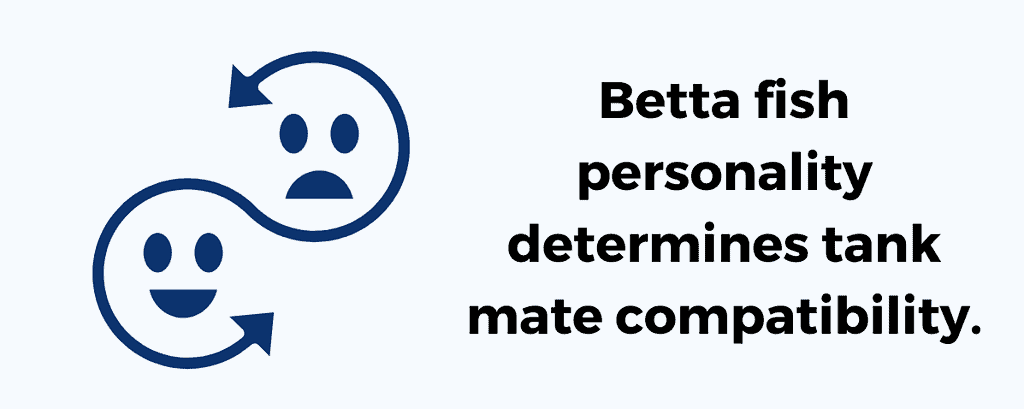
Several factors determine the compatibility between African dwarf frogs and bettas.
Taking these factors into consideration increases your chance of a successful community tank.
Temperament Compatibility
The personality of your betta fish is the main factor determining compatibility with other tank mates.
If you have an aggressive betta, it cannot be paired with other tank mates, even with the perfect setup.
Bettas are faster swimmers than African dwarf frogs. An aggressive betta could easily overtake your frog and bully them.
A feisty frog is also likely to fight back when attacked by a betta fish.
But not all bettas are extremely aggressive. If your betta has a more timid personality, it is the perfect candidate for a community tank.
African dwarf frogs are usually peaceful animals. They are happy living with other African dwarf frogs and have no interest in bothering other fish.
If your African dwarf frog nips at your betta’s fins, it is usually by accident.
African dwarf frogs have poor eyesight. Anything swimming past them may be seen as food.
Although African dwarf frogs do not have teeth, they can still damage a betta’s delicate fins.
The only time African dwarf frogs get aggressive is during feeding. They may feel threatened by a betta attempting to steal their food.
Diet Compatibility

African dwarf frogs are omnivores, but they prefer meat over plant matter.
Since African dwarf frogs do not have teeth, the food must be small enough for them to swallow.
The best staple food for African dwarf frogs is quick-sinking frog pellets. These are rich in protein and contain various essential vitamins and minerals.
Betta fish are carnivores, so they must have a high-protein diet.
A high-quality floating pellet with a high protein content like this one is best for a betta’s staple diet.
African dwarf frogs and bettas also enjoy a varied diet. Freeze-dried or frozen food options include:
- Blood worms
- Baby brine shrimp
- Daphnia
- Mosquito larvae
Only offer treats 2-3 times per week instead of a regular meal.
Avoid overfeeding your frogs and betta.
Bettas need 2 small meals daily with one day of fasting every week.
African dwarf frogs only need one small meal every day. If your frogs gain too much weight, you may reduce feedings to every other day.
How To Feed Your African Dwarf Frogs and Betta Fish

One issue with feeding is other fish out-competing the African dwarf frogs for food. African dwarf frogs can easily starve in a community tank if you are not careful.
African dwarf frogs are slow eaters. They may spend 15 minutes eating their meal.
Solve this issue by feeding your African dwarf frogs and betta fish on opposite ends of the tank.
Feed your betta floating pellets first. While the betta is distracted near the top of the tank, drop the sinking pellets in for your frogs.
Another problem with feeding African dwarf frogs is their poor eyesight. They may not see their food before the betta does.
A small feeding dish placed where your frogs eat may help with this problem. Another solution is hand-feeding your frogs with a pair of aquarium forceps.
Remove uneaten food when feeding time is over. This prevents bacteria and ammonia spikes in the tank.
Water Parameter Compatibility

African dwarf frogs and bettas come from warm waters.
The ideal temperature for African dwarf frogs ranges from 75-80° degrees Fahrenheit (27° C).
This means the standard betta tank temperature of 78° degrees Fahrenheit (26° C) works well for both species.
A neutral pH of 7.0 is best for African dwarf frogs and bettas.
The water parameter compatibility between these two species makes setting up the tank much easier.
Creating the Best Tank for African Dwarf Frogs and Bettas

Once you choose the right tank for your African dwarf frogs and betta fish, it is time to create the ideal aquarium space.
The proper aquarium setup is crucial to the health and well-being of your frogs and fish.
Substrate
Smooth aquarium gravel is the best substrate choice for this tank.
African dwarf frogs may accidentally ingest sand or very small rocks.
Aquarium gravel comes in a wide range of colors.
Choose a lighter color so your African dwarf frogs can find their food easier.
Aquatic Plants

Adding plenty of plants creates a natural environment and provides hiding places.
Some excellent plant options include:
- Anubias
- Java fern
- Dwarf water lily
- Betta bulbs
- Amazonian frogbit
- Guppy grass
- Water sprite
- Water lettuce
Bushy plants offer plenty of plant cover, making your frogs and betta feel more secure.
Flat-leaved plants give your frogs and betta places for relaxing or napping.
Avoid using plastic plants in your aquarium. The sharp edges may cause injury to your African dwarf frogs and tear your betta’s fins.
If you add any artificial plants, choose ones made of silk.
Hiding Spots

Your African dwarf frogs and betta fish need hiding spots for extra security.
Coconut caves, driftwood, and smooth rocks are all good options.
Avoid tank decorations with sharp edges. If an aquarium net snags on a decoration, it is too sharp for your frogs and fish.
Since African dwarf frogs have poor eyesight, they may hurt themselves by bumping into sharp objects.
Your betta’s flowing fins are also easily torn by sharp or rough surfaces.
Aquarium Heater
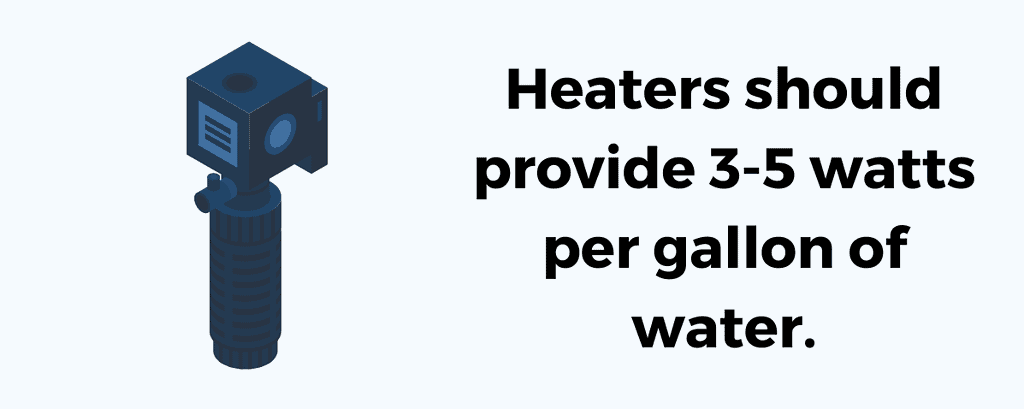
A quality aquarium heater maintains the warm temperatures you need for your frogs and betta.
The heater must provide 3-5 watts per gallon of water.
This means a 30-50 watt heater works well in a 10-gallon tank. For a 20-gallon tank, you need a heater with 60-100 watts of output.
Most aquarium heaters have a built-in thermostat. But even on the best heaters, these thermostats sometimes fail.
Use a separate thermometer for checking tank temperatures. Place the thermometer on the opposite end of the tank for a more accurate reading.
Filter System
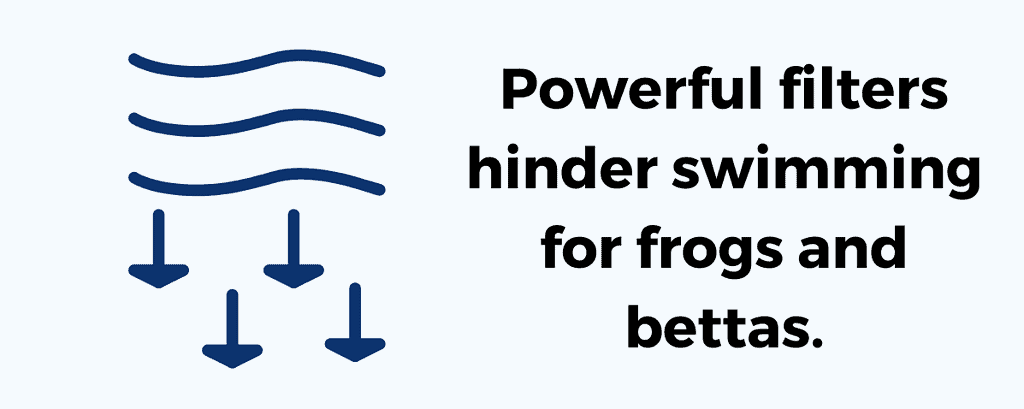
An aquarium filter helps remove toxins and bacteria from the water. It also provides oxygen circulation.
Choose a low-flow or adjustable filter for your tank. Powerful filters make swimming difficult for African dwarf frogs and betta fish.
The filter must circulate all of the water in the tank 4-6 times per hour. This rating is known as GPH, or gallons per hour.
Use a filter with a GPH of 40-60 for a 10-gallon tank. For a 20-gallon tank, you need a filter with a GPH of 80-120.
Place the filter next to the heater. This circulates the warm water throughout the tank for more stable temperatures.
Stable temperatures are vital for the health of your frogs and fish. Sudden temperature fluctuations may cause temperature shock or other illnesses.
Potential Health Risks: How To Prevent Them
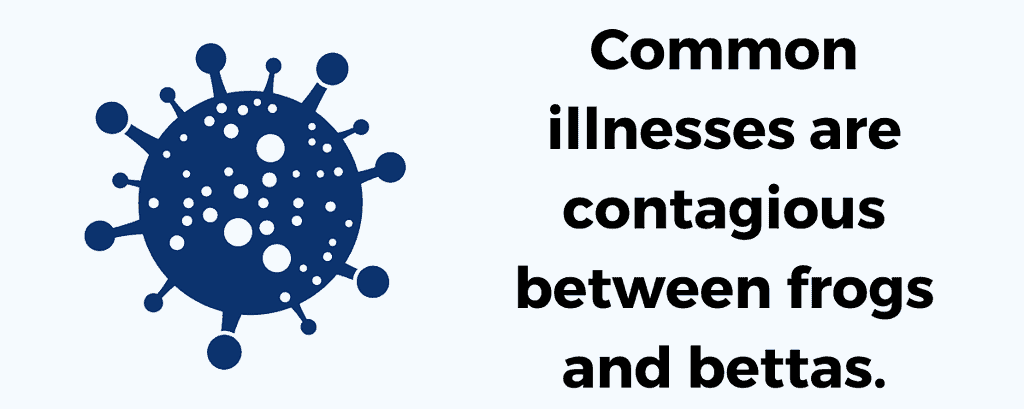
Several common illnesses are contagious between African dwarf frogs and bettas.
Poor water quality causes stress in aquatic creatures, which lowers their immune systems.
African dwarf frogs are especially prone to illness from stress.
Common Illnesses in African Dwarf Frogs
The most common illnesses in African dwarf frogs are dropsy and bacterial or fungal infections.
Dropsy
Bacterial infections and parasites cause dropsy. The disease is also contagious to other frogs and fish in the tank, including bettas.
An African dwarf frog with dropsy will have obvious symptoms, such as:
- Bloating
- Lethargy
- Loss of appetite
Mild cases of dropsy are treatable, but it is usually fatal.
Bacterial and Fungal Infections
A common fungal infection affecting African dwarf frogs is Chytridiomycosis.
This fungus causes fuzzy patches on the frog’s skin. It does not affect bettas, but it is contagious to other frogs.
If you suspect your frog has Chytridiomycosis, remove it to a quarantine tank immediately.
Bacterial infection systems include the following:
- Red patches of skin
- Red eyes
- Lethargy
- Loss of appetite
Your veterinarian may prescribe antibiotics for these types of infections. Bacterial infections are rarely fatal with prompt treatment.
Common Illnesses in Betta Fish
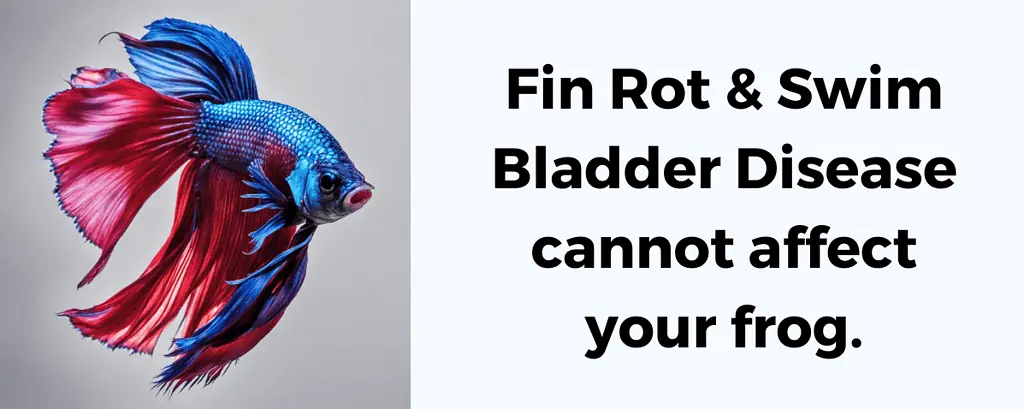
Besides dropsy, there are several illnesses found in bettas. The two most common betta illnesses are fin rot and swim bladder disease.
Neither of these diseases affects African dwarf frogs because they do not have fins or swimbladders.
Fin Rot
Bacterial and fungal infections cause fin rot in bettas. Fin nipping sometimes leads to fin rot.
This disease gives the fins a frayed and ragged appearance.
With fin rot, the edges of your betta’s fins are red, bloody, or black.
Treatment for fin rot involves antibiotic medications. This disease is not fatal unless it spreads to the body.
After treatment, the fins and tail grow back. The color and length of the fins may not be the same as they were originally.
Swim Bladder Disease
Swim bladder disease causes betta fish to float near the surface. Your fish may swim sideways or upside-down.
Bettas with swim bladder disease have a bloated belly. They may also refuse food.
There are several causes of swim bladder disease, such as:
- Constipation
- Overfeeding
- Parasites
- Physical injury
- Low water temperatures
The cure for swim bladder disease is not feeding your betta for about three days.
Ensure tank temperatures are between 78-80° degrees Fahrenheit (27° C). Warm temperatures help your betta digest its food.
Swim bladder disease is rarely fatal, and bettas recover quickly.
Preventing Illnesses in African Dwarf Frogs and Betta Fish

Preventing common illnesses in African dwarf frogs and bettas is simple.
Keep your tank clean and perform partial water changes every week. This prevents a lowered immune system caused by stress.
Feed your frogs and fish a nutritious diet for a healthy immune system.
Avoid overfeeding, as leftover food increases bacteria in the tank. Overfeeding is also the main cause of bloating and constipation, which leads to other health issues.
How To Acclimate African Dwarf Frogs and Bettas to the Tank
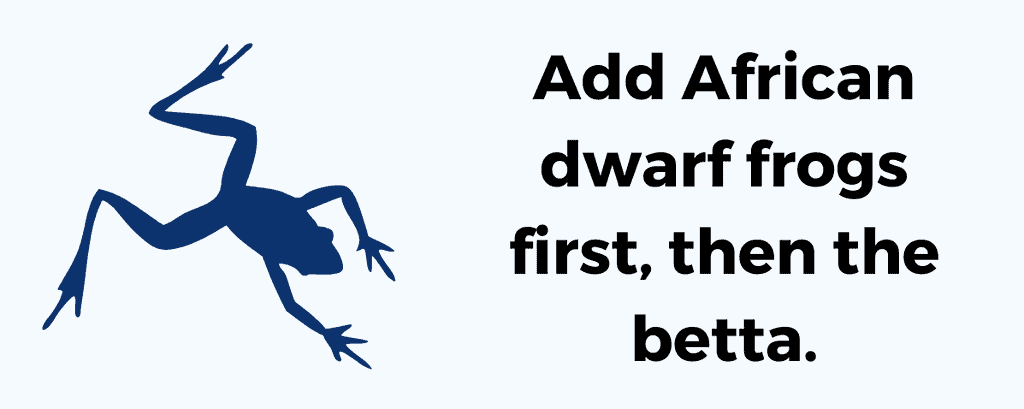
Acclimating your African dwarf frogs and betta to their new tank is crucial.
Proper acclimation reduces stress and ensures better compatibility.
If you already have a betta in a 10-gallon tank, we recommend temporarily removing the fish to a separate tank.
With the betta removed, rearrange the tank and ensure the water parameters are in the correct range.
Bettas are territorial and may see the entire tank as their space. A temporary move reduces this territorial behavior.
Always quarantine new tank mates for 4-6 weeks in a separate tank. This ensures they do not have diseases that might spread to the whole tank.
Once the tank is ready, you may add your African dwarf frogs first. Give them some time to explore the tank without the betta.
When the frogs have acclimated to the tank, add your betta.
Watch for any signs of aggressive behavior.
If your betta keeps bullying the frogs, consider adding a tank divider until things calm down.
Sometimes, a betta may not accept tank mates. In this case, keeping the betta in a separate tank is the only permanent solution.
6 Compatible Tank Mates for African Dwarf Frogs and Bettas

Several aquatic species are compatible with African dwarf frogs and bettas.
If you have a 30-gallon tank and wish to add more companions, the following species are excellent choices.
1. Nerite Snails
Nerite snails are algae eaters and are great for keeping your glass and substrate clean.
Unlike some species, nerite snails cannot breed in freshwater. They may lay eggs, but they only hatch in saltwater conditions.
2. Neon Tetras
Neon tetras are peaceful fish, and they get along well with African dwarf frogs and bettas.
These small fish enjoy swimming in groups of six or more, so be sure you have enough aquarium space for them.
3. Corydoras Catfish
Corydoras catfish swim along the bottom of the tank.
Like neon tetras, they are a shoaling species. Corys prefer groups of at least 4-6, so a 30-gallon tank ensures there is ample space for them.
4. Otocinclus Catfish
Otocinclus catfish are excellent tank cleaners with a docile temperament.
If there is not enough algae in your tank, you must feed them algae wafers to supplement their diet.
These fish are also very social and feel more secure in large groups of 6-10 fish.
5. Harlequin Rasboras
Harlequin rasboras are peaceful fish and share the same diet as bettas.
This schooling fish does well in groups of 6-10 fish. They do not grow very large, so a 20-gallon tank provides ample space.
6. Endlers
Endlers have a docile temperament and are fast swimmers.
They are not a threat to African dwarf frogs or bettas. Their lack of flowy fins means bettas mostly ignore them.
5 Tips for Maintaining Optimal Water Quality

Maintaining optimal water quality is vital for the health of your frogs and betta.
African dwarf frogs and betta fish are sensitive to toxins and sudden changes in water parameters.
There are no acceptable levels of ammonia or nitrites, and nitrates must be less than 40 ppm.
1. Perform Weekly Water Changes
Partial water changes prevent the buildup of toxins in your tank.
Only remove 20-25% of the water at a time. Removing more than this may crash your nitrogen cycle and destroy beneficial bacteria.
Add a water conditioner to the new water before pouring it into the tank. The water conditioner removes harmful chlorine.
Ensure the new water is close to the same temperature as the tank. This prevents sudden changes in tank temperature.
2. Avoid Overfeeding
Overfeeding is not only unhealthy for your fish, but the leftover food causes ammonia spikes and produces bacteria.
Feed your frogs and betta small meals. Remove uneaten food 30 minutes after feeding time.
3. Test Your Water Regularly
Aquarium testing kits tell you everything you need to know about your water parameters.
Most kits test pH, ammonia, and nitrate levels.
Use your testing kit often, and ensure your water parameters are within the correct range.
4. Clean Your Tank Often
During weekly water changes, it is a good time to clean your tank.
If you do not have algae eaters, you need an algae scraper. Magnetic algae scrapers effectively remove algae from the sides of your tank.
You must also clean the substrate with a gravel vacuum. This removes uneaten food and fish waste from the substrate.
Remove dead plants from the tank as well. Dead plants create high levels of ammonia when they decay.
5. Maintain Stable Temperatures
Stable temperatures are crucial for your tank.
Sudden fluctuations in temperature may cause temperature shock in your frogs and fish.
Always ensure new water is at the same temperature as the water already in the tank.
Avoid placing the tank near sunny windows or heating/air conditioning vents.
5 Unique Behaviors of African Dwarf Frogs and Betta Fish

African dwarf frogs and betta fish often display unique behaviors. This sets them apart from most other fish species.
1. African Dwarf Frogs and Bettas Breathe Air
African dwarf frogs do not have gills, despite living in the water. Instead, they have well-developed lungs and need to breathe air.
You may see your frogs go to the surface occasionally for breathing.
Bettas have gills, but they also breathe air. This is because bettas have a labyrinth organ.
They developed this labyrinth organ because of their natural habitat. The shallow rice paddies and marshes bettas come from do not contain adequate oxygen.
Bettas also use their labyrinth organ to create bubble nests when mating.
2. African Dwarf Frogs Like To Float
It is not uncommon for your African dwarf frog to float on the surface.
You may think your frog is dead, but this is just a way of relaxing.
Floating is completely normal behavior for aquatic frogs, so don’t let it shock you.
3. African Dwarf Frogs Are Nocturnal
Unlike betta fish, African dwarf frogs are nocturnal creatures.
Your frogs may spend much of their day napping. But, at night, they are more active.
I’m not sure if this affects a betta’s beauty sleep, but in my experience, the fish is primarily unbothered.
Be sure you turn off your aquarium lights at night. Leaving the lights on can disrupt an animal’s circadian rhythm.
4. African Dwarf Frogs and Bettas Can Jump Out of the Tank
African dwarf frogs and bettas can jump out of the tank, so you need a lid on at all times.
If your frog or betta leaps from the tank, it can quickly dehydrate and die.
Without a lid on the tank, you may find your beloved frog or betta on the floor around the tank.
Avoid this tragic fate by ensuring the lid is always secure on the tank.
5. African Dwarf Frogs Sing for a Mate
You may hear a strange humming sound from your frogs every once in a while.
Do not be alarmed. Male African dwarf frogs “sing” when they are ready for mating.
This humming sound is meant to attract female frogs.
Taking the Leap With African Dwarf Frogs and Betta Fish
African dwarf frogs and betta fish usually make excellent tank mates.
Both species can live in the same tank conditions and get along well in a larger tank.
Compatibility is not always guaranteed, though.
Even in perfect tank conditions, things do not always work out.
Have a backup plan with a separate tank just in case your frogs and betta do not get along.
For other options, check out our article on the best tank mates for betta fish.


